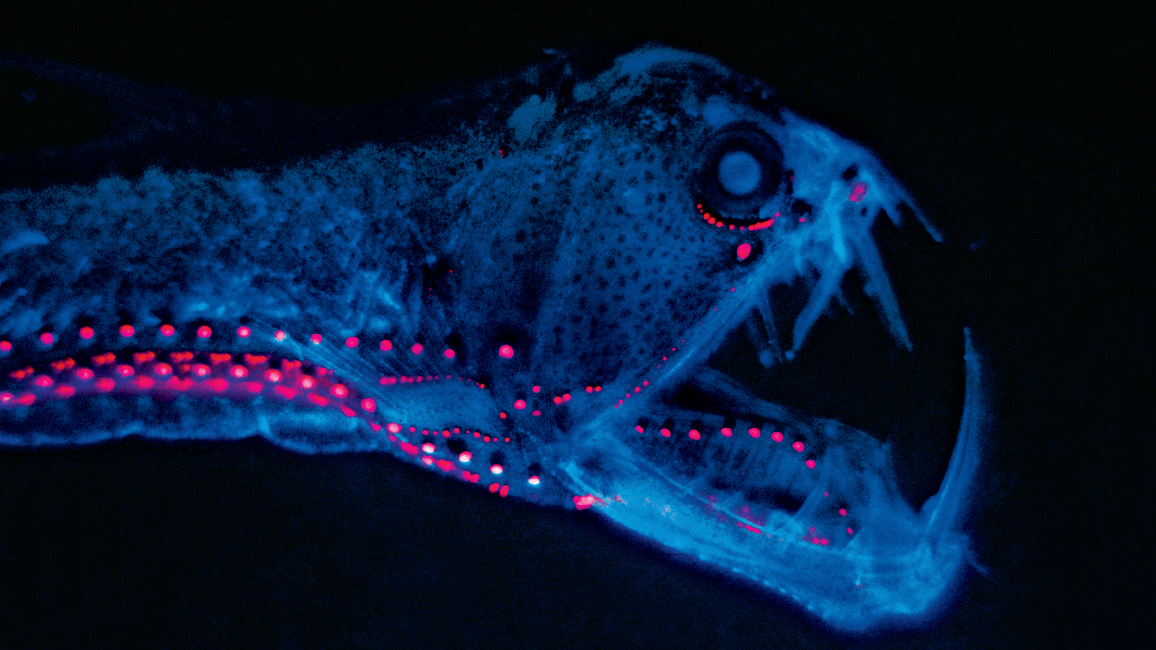
Let it Glow
By Kathy KrankingCheck out nature’s blinking, twinkling, LIVING lights!
Welcome to the brightest show on Earth. You’re about to meet some very special creatures: fishes, insects, and other living things that glow in the dark! They make the light with chemicals in their bodies. This is called bioluminescence (bye-oh-loo-muh-NESS-ens). (Bio means “life” and luminescence means “light.”)
Living lights come in different colors. In the ocean, bioluminescence is usually blue, and on land it’s usually yellow or green. But in both places it can come in other colors, too.
Bioluminescent lights can be dim or very bright. Some flash, while others are always glowing. And different creatures use bioluminescence for different reasons. The light can attract prey or signal a mate. It can scare off predators or even be used to “disappear”! Keep reading as this story sheds more light on bioluminescence.
HIDING IN PLAIN SIGHT
This viperfish uses the glowing dots on its body to make itself “invisible.” Lights from the camera make the dots look pink in this picture, but normally they glow blue. To predators swimming beneath the fish, the glow matches the faint light coming down from the ocean surface. The actual shape of the viperfish blends into the dark. Viperfish? What viperfish?
LIGHTS ON FOR LUNCH
In the deep, dark part of the ocean where this dragonfish lives, it’s not always easy to find food. So the dragonfish lets food find it. Hanging from the bottom of its jaw is a glowing lure. When hungry fishes or shrimps come to check it out, the dragonfish gobbles them up.
SILENT SCREAM
This beautiful deep-sea jellyfish has a great way of protecting itself from predators. It uses a bioluminescent “burglar alarm”! Here’s how it works: If a hungry fish or other predator comes near, the jelly turns on its “flashlight”. The light is like a scream for help. It puts the predator in a spotlight, and that may attract bigger predators to attack and eat it, while the jellyfish safely floats away.
GLOW CONE
You might scream for this ice cream. When you take a lick, it starts to glow! The ice cream contains a protein from a bioluminescent jellyfish. Scientists have been experimenting with different ways to use human-made copies of this and other glow-producing proteins. One possible use: Save electricity by using glowing trees instead of street lights!
SHINING SEA
The tiny “bubbles” in the circle are sea sparkle dinoflagellates (dye-noh-FLAJ-uh-layts), a kind of plankton. And as you can see here, they really live up to their name! When something—such as a predator, a boat passing through, or even the movement of waves—disturbs them, they light up by the billions. The light may help to startle predators.
ON LAND
SAY IT WITH FLASHERS
These woods have turned into a firefly chat room! When it’s mating time, fireflies have conversations that can be seen rather than heard. The males send flashy messages to attract females. And the females answer them. Each species of firefly has its own pattern of flashes—its very own language of light!
HIGH BEAMS
The click beetle has two bright spots of light that glow behind its head. The lights have a built-in dimmer switch. If the beetle feels threatened, it can turn the lights brighter. Then it dims them again when it feels safe. The lights also may help protect the beetle by making it look bigger.
ALL ABOARD?
When it’s showing its glow, the railroad worm looks like a tiny train in the night with lighted windows and a red headlight. If the worm wants to scare away a predator, it can blink its “window” lights. It uses the “headlight” as a flashlight to help it see.
HAUNTED MUSHROOMS
These jack-o’-lantern mushrooms always look as if they’re ready for Halloween. During the day, they’re a bright orange color that gives them their name. And at night, they give off an eerie green light. Scientists have different ideas about why the mushrooms glow. For example, the light might attract insects that help spread the mushrooms’ seed-like spores. No one knows for sure—yet.
Now you know why bioluminescence is one of nature’s brightest ideas!
“Let it Glow” originally appeared in the August 2015 issue of Ranger Rick magazine.
(Click on each image above for a closer view of the story.)



















